
- 17" Elite Series Range
- 22" Elite Series Range
- 17" Elite Series Plus Range with Built in Cover
- 22" Elite Series Plus Range with Built in Cover
- 3 Burner Slide-In Cooktop
- 3 Burner Slide-In Cooktop Cover
- Drop-In 2 Burner
- Drop-In 2 Burner Cover
- Drop-In 3 Burner
- Drop-In 3 Burner Cover
- Single Element Induction Cooktop
- Double Element Induction Cooktop
- Horizontally Ducted Range Hood
- Ventless Range Hood
- 18" Elite Series Griddle
- 23" Elite Series Griddle
- Elite Series Microwave Oven
- Outdoor Kitchen, Large
- Outdoor Kitchen with Sink, Large
- Outdoor Kitchen, Small
- Outdoor Kitchen with Sink, Small
- Suburban/CAN Dual Burner
- Suburban/CAN Dual Burner Sink Stove Combo
- Suburban/CAN Slide Out Kitchen
- Suburban/CAN Single Burner Sink Stove Combo
- Suburban/CAN Round Sink with Glass Lid
- Advantage Direct Fit Water Heater
- Direct Fit Water Heater Door
- 4 Gallon Tank
- 6 Gallon Tank
- 10 Gallon Tank
- 12 Gallon Tank
- 16 Gallon Tank
- E-Series 120V - Door Version
- E-Series 120V - Interior Version
- Tank Water Heater Control for D DE
- Tank Water Heater Control for DEL
- Exterior Water Heater Doors
- Replacement Anode Rod
- Advantage Water Heater
- ST-42 Water Heater
- ST-60 Water Heater
- Advantage Tankless Water Heater Control
- Replacement Door Panel
- SF-Q Series Furnace
- SF-Q Series Furnace Access Door
- SF-FQ Series Furnace
- NT-SEQ Series Furnace
- Replacement Core 2605A
- Replacement Core 2606A
- Replacement Core 2607A
- Replacement Core 2608A
- Replacement Core 2609A
- Replacement Core 2610A
- Replacement Core 2612A
- Replacement Core 2614A
- Replacement Core 2615A
- Furnace Thermostats
- Furnace Duct Collars
- 120V Electric Wall Heater
- Voyager Fire Pit
- LP Gas Accessories
- Stow Away Steps
- Download Catalog
- Extended Suburban Warranty Form

Direct Fit Replacement Water Heaters
The Suburban Advantage Direct Fit Upgrade Tank Water Heater is the ONLY water heater on the market that is A DIRECT REPLACEMENT AND DOES NOT REQUIRE: cut-out modifications; interior cabinet modifications for depth; OR major modifications for plumbing connections.
The Suburban Advantage Direct Fit Upgrade Tank Water Heater is the most economical choice when replacing a competitve aluminum tank water heater.
In most cases, the water heater is virtually always out of sight, but is rarely ever out of mind. At Suburban, we feel that the water heating system is one of the most important components for providing comfort. With this in mind and using our extensive knowledge of water heaters and our expertise, we developed the Suburban Advantage Direct Fit, Upgrade Tank Water Heater.
THE SUBURBAN ADVANTAGES:
Porcelain lined steel tank:.
Built just like longer lasting residential tank water heaters.
Protects against tank corrosion and doubles as a drain.
OPTIONAL ELECTRIC ELEMENT:
Take advantage of campsite or generator power to heat water.
INDUSTRY EXCLUSIVE FLUE TUBE BAFFLES:
Slows combustion process to transfer more heat to water in tank.
Additional Advantages:
- Longer lasting, residential style porcelain lined steel tank
- Repositionable module board provides installation flexibility
- Backed by a 2 year limited warranty and the tank is backed by a 3 year tank limited warranty - the best in the RV industry
- Assembled in the USA by Suburban, the leader in RV water heaters
Suburban Advantage Direct Fit Upgrade Tank Water Heater doors and ON/OFF Switches are sold separately.
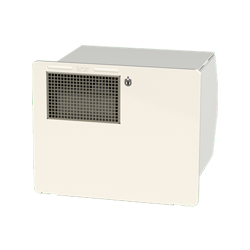

rv Education 101
Replacing your rv hot water heater from rv education 101.
Hi, I’m Mark Polk with RV Education 101. Today we’re going to replace an Atwood 6-gallon aluminum tank RV water heater with the Suburban Advantage 6-gallon RV water heater. The Suburban Advantage water heater comes with a residential style porcelain-lined steel tank, an anode rod, both of which protect against tank corrosion and extend the life of the water heater.
Let’s start removing the old aluminum tank water heater right now. Step one, turn the LP gas supply off at the cylinders or tank. Step two, turn any water supply going to the RV off and make sure the Dometic water heater is in the bypass mode. Step three, using a pair of pliers, loosen and remove the water lines from the brass or plastic inlet and outlet fittings on the back of the water heater tank.
Step four, use two wrenches to loosen and separate the LP gas inlet connection. Step five, remove the hinge clip and remove the door to improve access to the screws on the control housing mounting flange. Step six, remove excess silicone as required to slip the inlet gas connection out of the control panel. Prior to pushing the inlet connection through the control housing opening, make sure a male 3/8th inch plug is threaded into the 3/8th inch flare gas connection.
Step seven, remove all screws from the control housing mounting flange. Step eight, remove any silicone from the top of the water heater. Step nine, bend the control housing mounting flange 90 degrees forward and start removing the water heater from the cutout in the RV. With the water heater halfway out, disconnect any electrical connections. Remove the old water heater.
Step ten, remove the inlet and outlet 90-degree elbows or straight fittings from the back of the old water heater and save them to install on the new Suburban Advantage 6-gallon water heater.
Installing the Suburban Advantage 6-gallon water heater.
Step one, apply pipe dope or Teflon tape to the ends of the fittings that go in the new tank. Install the 90-degree elbows or straight fittings on the back of the new water heater tank. Make sure the fittings are positioned correctly to reattach the water lines. Step two, remove any old sealant from around the water heater opening and clean the surface. Be careful not to damage any graphics or decals. Step three, this is a good time to remove the old cone washers from the hot and cold water line fittings and replace them with new cone fittings.
Step four, install butyl tape to the backside of the water heater mounting flanges. Step five, position the water heater partially into the framed opening. Step six, route the inlet gas line through the control housing gasket. It might be necessary to remove the grommet from the control housing. Step seven, connect the 3/8th-inch LP gas supply line to the 3/8th-inch flare fitting at the gas valve located in the control housing. When making the gas connection, hold the gas fitting on the valve with the wrench while tightening the flare nut. After making the gas connection at the valve, reinstall the grommet.
Step eight, bend the control housing flanges 90 degrees and press firmly against the side of the RV. Step nine, while pushing the unit against the butyl tape, secure the four corner brackets to the RV using number eight screws or equivalent. Step ten, secure the water heater to the RV’s exterior by inserting the same type of number eight screws in all of the holes provided around the flange of the water heater control housing.
Step 11, use sealant around the opening to seal the control housing for a watertight seal against the RV’s exterior and seal any openings around the grommet at the gas line. Step 12, to secure the door, snap the hinge pin into the clip on one side of the control housing and slide the corresponding side of the door into the hinge pin. Next, slide the hinge pin into the opposite side of the door and snap it into the clip at the same time.
Step 13, access the back of the unit. Locate and position the module board as required. The module board must be mounted so it is accessible for service, yet out of the way of children. It should be located in an area where it will not be subjected to moisture, cleaning chemicals, and flammable vapors and liquids. The module board can be mounted using the adhesive backing or with two number six by 5/8th-inch screws or other suitable hardware.
Step 14, make the 12-volt DC electrical connections following the applicable model wiring diagrams in the instruction manual. Step 15, make the water connections at the back of the unit connecting the hot and cold water lines.nStep 16, fill the water tank with water. Open both hot and cold water faucets to expel air from the tank. When the tank is full and water flows from the faucets, close both faucets and check all connections for leaks.
Step 17, turn the LP gas supply on and check all fittings and connections for leaks using an approved soap and water solution. Correct even the slightest leak immediately. When the job’s over, you have the advantage of a residential style porcelain-lined steel tank that extends the life of the water heater and comes with the industry best warranty to back the product.
You also get a water heater with a higher recovery rate, reducing the amount of time required to continue the supply of water at the desired temperature.

How to Replace an RV Water Heater | A Step-by-Step Guide for DIY Repair
Replacing an RV water heater can be a real pain, but I’m here to walk you through it step-by-step. I know it seems daunting, but have no fear – you totally got this! Just get your tools and materials together and we’ll go through it real easy-like. Safety first though – we gotta turn off the power and water so there’s no surprises. I’ll be with you the whole way, from draining the old one to testing the new heater. With a little time and patience, we’ll have your RV hooked up again before you know it. So let’s get started and get your hot water flowin’! It’ll be a piece of cake, I promise. Just stick with me and we’ll knock this project out, no problem.
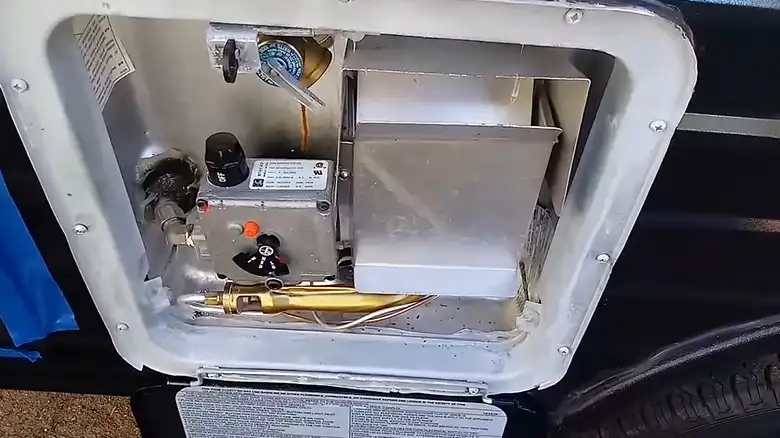
Step 1. Gather the Necessary Tools and Materials
Replacing an RV water heater requires gathering a few key tools and materials ahead of time. Having these ready will make the process smoother.
Tools Required:
- Screwdrivers – Have both Phillips and flat head screwdrivers on hand.
- Adjustable wrench – Helpful for loosening fittings and connections. Avoid over-tightening.
- Pipe wrench – Provides extra grip and torque for stubborn connections.
- Teflon tape – Used to seal threaded pipe connections.
- Pipe cutter – For cutting water lines to size if needed.
- Plumber’s tape – To wrap pipe threads and prevent leaking.
- Voltage tester – For testing electrical connections safely.
Materials Needed:
- New RV water heater – Choose a unit with similar dimensions and connections as the old one.
- Replacement fittings – For any damaged or corroded fittings that need replacing.
- Pipe insulation – To insulate any exposed portions of the new water lines.
- Pipe sealant – Used on fittings to prevent leaks. Look for RV-specific sealant.
Having all the necessary tools and materials will prevent delays in the project. Check that everything works beforehand.
Step 2. Turn Off the Power and Water Supply
Before draining and removing the old RV water heater , the power and water supply must be turned off . This is an essential safety step. You’ll need to locate the circuit breaker for the water heater and switch it to OFF .
For propane units , turn the propane supply valve to OFF .
For electric models , unplug from any outlet. Then find the main water supply valve , usually near the water hookup inlet on the RV exterior. Turn the valve clockwise to OFF to shut off water to the entire RV. With power and water supply halted, the old unit can now be drained and disconnected safely.
Step 3. Drain the Old Water Heater
Before removing the old RV water heater, its tank must be fully drained to prevent any remaining hot water from spilling out. You’ll need to locate the drain valve at the bottom of the tank and attach a hose to the valve spout so hot water can drain safely away. Find and open the pressure relief valve on the tank to allow air in so water can drain out. Place a bucket under to catch any released water. Turn the drain valve to OPEN and allow all water to fully drain. Once empty and only air comes out, close the drain. The old unit is now ready for disconnection and removal.
Step 4. Disconnect the Old Water Heater
Before unbolting the old heater, its gas, water, and electrical lines must be disconnected. You’ll need to turn OFF the gas suppl y at the propane tank or natural gas hookup, then loosen and disconnect the gas line with a pipe wrench. Cap the open line to prevent leaking . Loosen the cold inlet and hot outlet water lines with pliers or a wrench and cap the open ends. Unscrew the electrical cover plate and detach the wires, labeling them for proper reconnection later. The old unit is now ready to come out.
Step 5. Remove the Old Water Heater
With all connections detached, unbolt and remove the water heater from the RV. Locate the mounting bracket bolting it in place and unscrew each bolt while supporting the weight . Slowly pull out the old heater , taking care not to spill any water remaining inside or damage surrounding structures. Carry the empty old heater out and set it aside.
Step 6. Prepare the New Water Heater
While the space is clear, inspect the new replacement unit thoroughly for any defects and verify it matches the RV model. Install any necessary adapters, valves, or fittings according to manufacturer instructions. Refer to the old heater setup if needed. Wrap all threaded pipe connections with 2-3 layers of Teflon tape to prevent leaks when installing. The new water heater is now prepped and ready for installation.
Step 7. Install the New Water Heater
With the old unit out and the new one prepped, it’s time to securely install the replacement. Carefully lift the new heater into place under the mounting location, aligning it with screw holes. Insert mounting bolts through the holes and tighten them securely with a wrench. Reconnect the cold and hot water lines to the proper fittings, using sealant and tightening with a wrench. Reconnect the gas line and check for leaks after turning on the supply. Attach electrical wires per the wiring diagram and secure the cover plate. The hard work is done!
Step 8. Test the New Water Heater
With secure connections, turn on water and power to test the replacement. Locate the main valve and turn it to OPEN, checking fittings for leaks and tightening if needed. Restore electrical power and propane supply. With pressurized water flowing, inspect thoroughly for leaks and fix any immediately. Run a hot tap to prime the new tank and ensure the temperature reaches around 120°F.
Step 9. Insulate Pipes and Clean Up
With the new heater working, wrap any exposed pipes nearby with insulation to prevent heat loss. Use foil wrap or tape to secure the insulation tightly. Discard any debris, wipe up spills, and restore any displaced interior surfaces.
Step 10. Final Checks and Troubleshooting
Do one final inspection of all connections for tightness and leaks. Retest hot water temperature at all faucets. If any issues arise such as no hot water, check the power supply and gas valve position first. For leaks, tighten fittings and check for cracks. Refer to the user manual for other troubleshooting tips.
Replacing an aged or faulty RV water heater is a major project, but this step-by-step guide has equipped you to DIY the repair and save hundreds in labor costs. Gather the right tools and materials, follow safety procedures, and take your time. While hiring a professional is an option, have confidence you can get your RV’s hot water working again by meticulously installing a new heater. Here’s to many more safe and comfortable RV adventures ahead!
Similar Posts
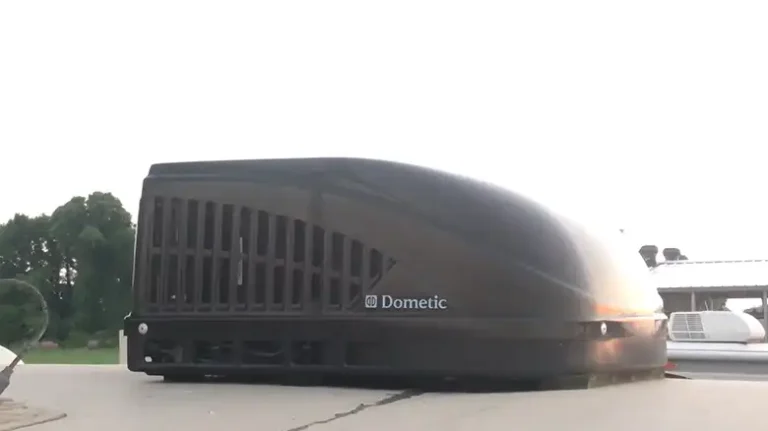
RV Air Conditioner Making Loud Noise | What Tricks Taken by Me
RV travel provides a sense of adventure and the opportunity to explore the great outdoors, but when your RV air conditioner starts making a loud noise, it can put a damper on your journey. The tranquility of your camping experience is disrupted, and you might be wondering why this issue is occurring. Clogged filters, loose…
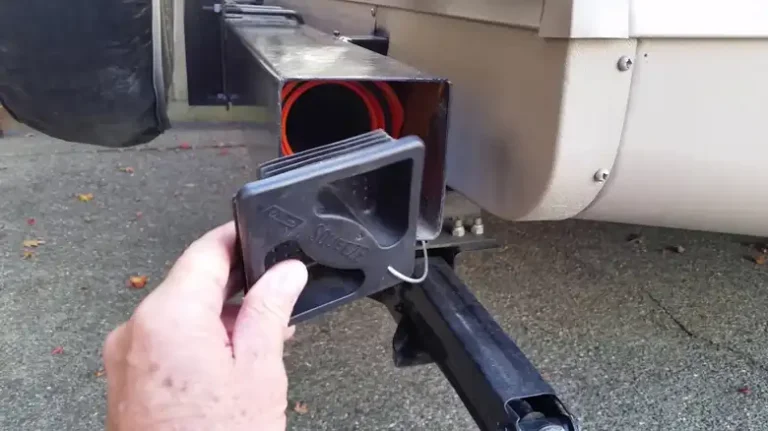
How to Keep RV Bumper Caps On? A Complete Solution for You
RV bumper caps serve an important function. They protect the vulnerable edges of your rear bumper from cracks, dents, rust, and other damage that can occur. However, these plastic end caps often become loose and fall off over time due to frequent travel vibrations, minor impacts, sun exposure, and more. You might one day walk…
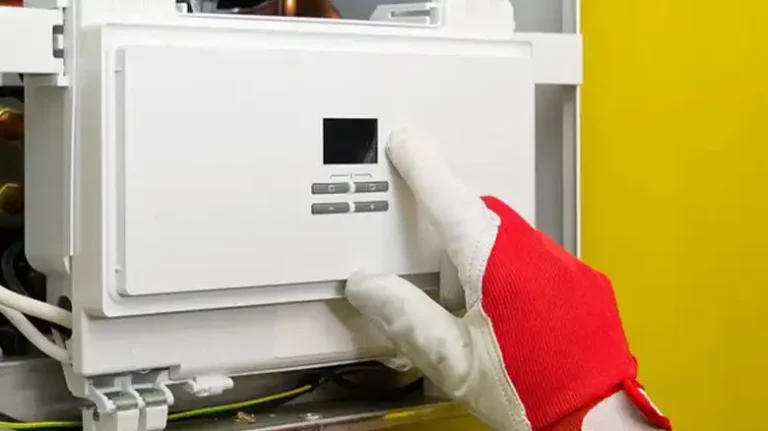
Tripped Circuit Breaker Won’t Reset | What Did I Do?
As an avid RV enthusiast who has experienced my fair share of electrical issues on the road, I can attest to the frustration of encountering a tripped circuit breaker that stubbornly refuses to reset. Whether you’re a seasoned RV owner or a newbie, this article will guide you through the process of diagnosing and resolving…
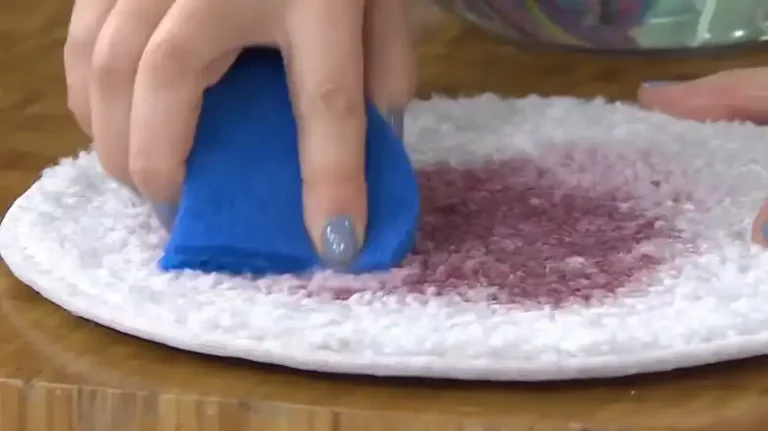
Stain Removal Tips for Common RV Spills and Accidents
RVing can be an amazing experience, allowing you to see beautiful sights across the country. However, spills and stains are an inevitable aspect of life on the road. From red wine mishaps to muddy pet paws, RV stains happen! As a new RVer, I used to panic when stains set into my RV’s soft furnishings…
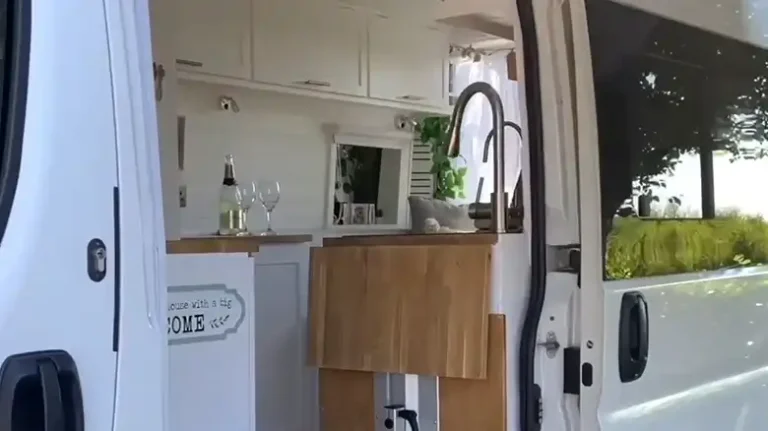
Water Not Flowing In RV | Causes And Fixes
RVing is a great option to get rid of work stress, depression, and many other negative vibes. But to ensure this, it’s a must to make RVing hassle-free and overall enjoyable. Truth to speak, RVing isn’t always hassle-free, especially when you encounter a frustrating hiccup like the water in your RV isn’t flowing as it…
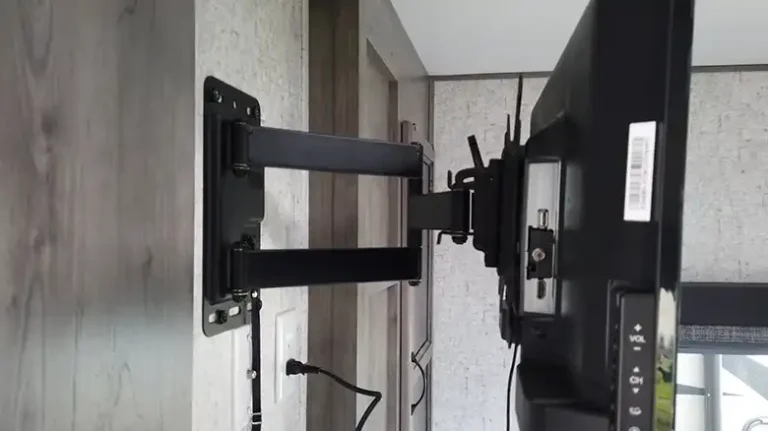
RV TV Not Picking Up Cable Channels: It’s Troubleshooting Time
As an avid RV enthusiast, I know that one of the simple joys of life on the road is kicking back in the evening, maybe with a bag of popcorn, and watching your favorite TV shows. But there’s nothing more frustrating than when your RV TV refuses to cooperate, particularly when it’s not picking up…
Leave a Reply Cancel reply
Your email address will not be published. Required fields are marked *
Save my name, email, and website in this browser for the next time I comment.


The Savvy Campers
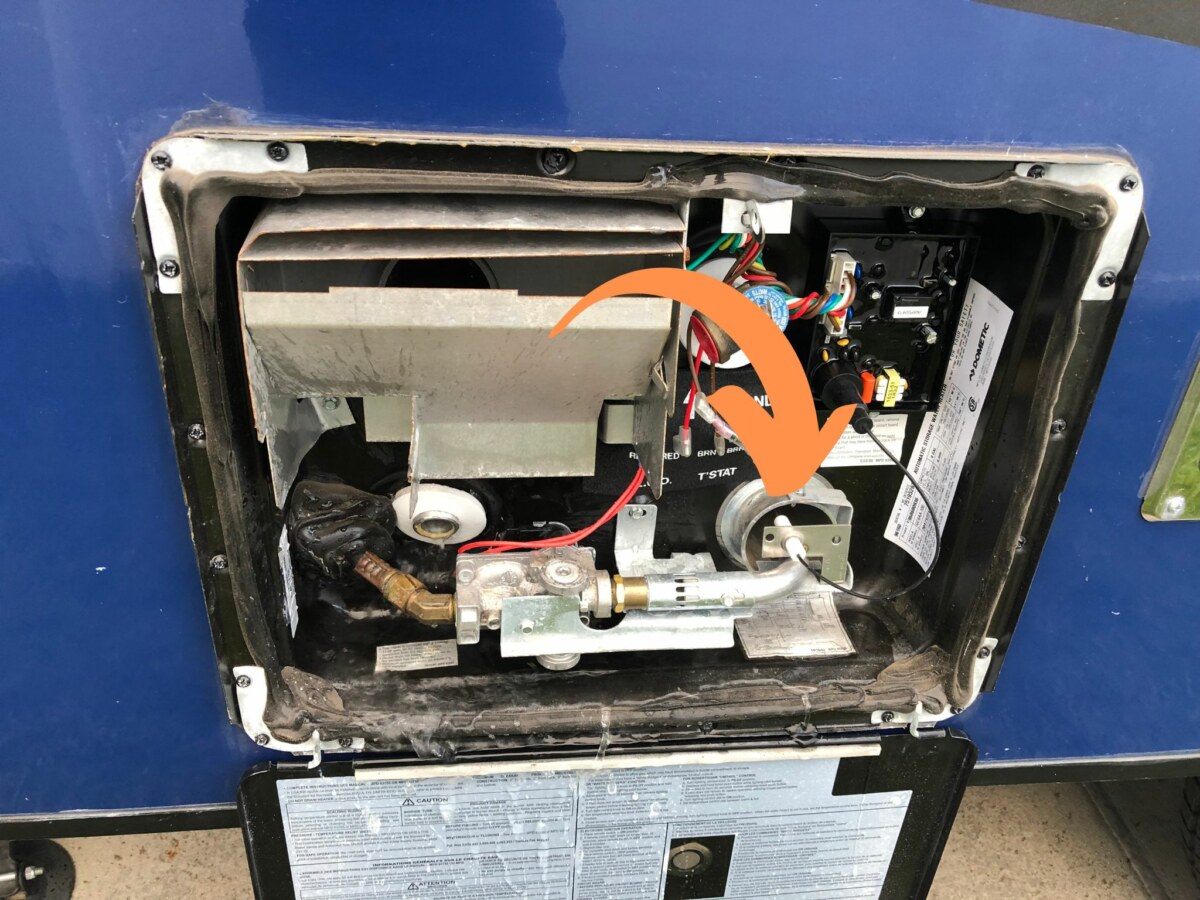
RV Water Heater Thermocouple Testing and Replacement: A Step-by-Step Guide
Being on vacation camping can be very frustrating when your water heater stops producing hot water. Trust me, I know all about it. On our first trip our hot water heater stopped working on the gas function and we did not have plug ins. So frustrating!!!
The first thing many of us will do is check the pilot light. Inevitably it will be out. On the other hand, it could be the wind, so you light it again, and after a few minutes, it goes out again. After some research, you will find suggestions for testing and replacing your thermocouple.
When testing or replacing the RV water heater thermocouple, first, you must shut off the gas. Then after locating the thermocouple, use a multimeter to check resistance. Then heat the thermocouple with an open flame to test the current. If there is no reading on either, replace it with a new one.
Here is an excellent guide on testing if your thermocouple needs replacement. If it needs replacement, we will guide you through replacing it. We also included a bonus section on cleaning the thermocouple from soot buildup.
How Do You Test If The Thermocouple / Igniter Is Working
Using a digital multimeter, you should check the resistance and current of the thermocouple. With proper resistance and current flow, the thermocouple will not work, and your gas supply safety cut-off switch will activate and extinguish the flame.
Tools You Required To Test And Replace An RV Thermocouple
- Screwdriver (Phillips, hex, or flat-head)
- A multimeter that can test milliamps and resistance
- Adjustable wrench
- Long nose pliers
- Replacement thermocouple (and installation guide included in the box)
- Utility Lighter to reach the thermocouple.
Step 1: Turn Off The Gas Supply
First, you must turn the gas supply off to your water heater, stove, or furnace by locating the gas valve and turning the knob to the “Off” position. You can also uncouple the gas bottle if you are unsure of where the turn-off switch is.
Step 2: Locate The Thermocouple
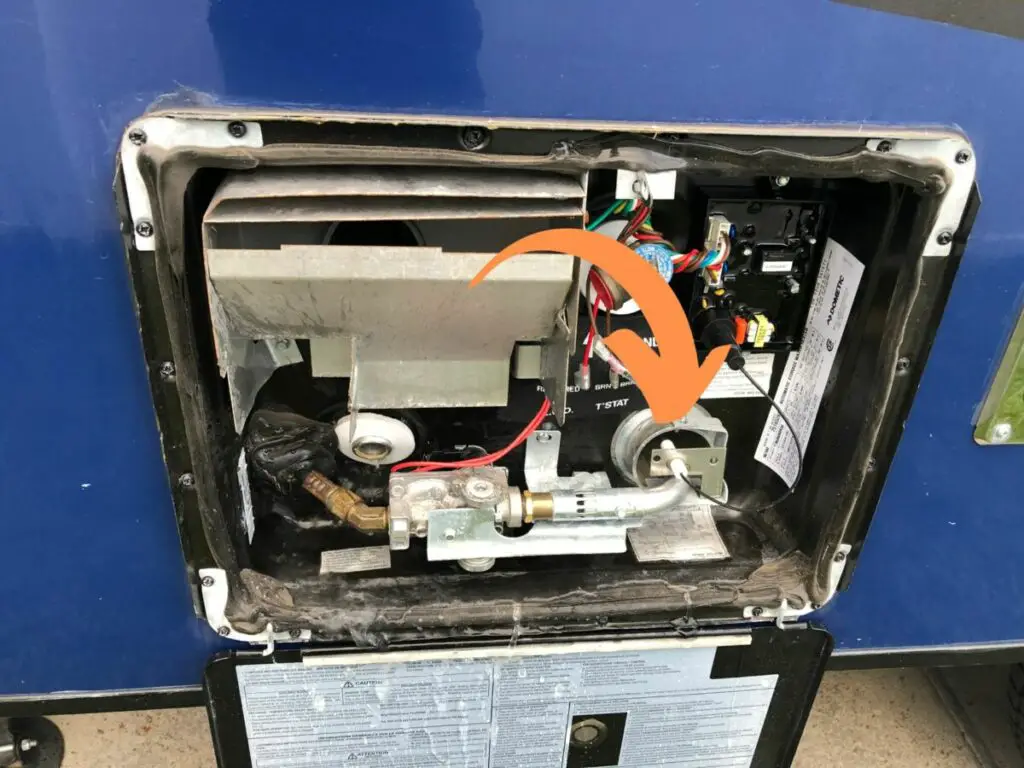
The first thing to do is test the thermocouple’s resistance. Locate the thermocouple attached to the plate next to the pilot light. It should look like a metal rod that extends into the flame. Follow the thermocouple’s body, and it should have 2 wires going into the electronic box.
Step 3: Locate The Thermocouple’s Leads
Open the box and follow the leads from the end of the thermocouple to where it goes into the electronic housing. You will see where it is plugged in. It will say something like J3 and J11 thermocouple, but it depends on your system.
Step 4: Test The Thermocouple’s Resistance
Carefully remove the thermocouple leads with longnose pliers from the electronic board. Now you are ready to start to test with the multimeter. A thermocouple is supposed to have meager resistance. Place the positive (Red) on one cable and the negative (Black) lead on the other. Turn the multimeter on and select OHM (Ω) for resistance. If you get 0.3 to 0.5 ohms, your thermocouple resistance tests were good.
Step 5: Test The Thermocouple’s Current
Then the next thing you’re supposed to do is to check the current. How a thermocouple works are while it is hot, it will have a current flow. The moment it cools down, the amperage will fall and will cause the gas valve to shut off. If the pilot light goes out, this safety mechanism prevents your RV from filling up with gas.
Now sets your multimeter to DC milliamps (mA). Heat the thermocouple’s head (the end where the pilot light is) with a lighter, or turn the gas back on and ignite the flame. It will almost immediately start going up in milliamps. A good reading should be between 20 and 30 mA. If it is below 20, but above 10mA, you might have a dirty thermocouple, which needs a good cleaning.
If it has no resistance or current, you will need to replace it. See the section on replacing the thermocouple.
A good cleaning might be all you need if it has a low current but good resistance. See the section on cleaning the thermocouple.
Step 6: Turn The Gas Back On
Reconnect the gas supply and turn the gas valve knob to the “On” position if you did not do it in step 5.
If you are out at the campground and your thermocouple is not reading heat, try using some sandpaper to lightly sand down the metal. This may remove a block up of soot so it can start reading again. Once you are back at camp, look into purchasing a new one to have as a backup. Here is a good replacement model.
How To Replace The Thermocouple
Here are the replacement steps you need to follow to exchange the RV water heater thermocouple.
Before working on them, you must first turn off the gas supply to the RV’s stove, furnace, or water heater. Typically, this is accomplished by adjusting a valve on the main gas line or near the affected appliance. Turning off the gas supply while working is critical to avoid gas leaks or fires.
Locate the thermocouple near the control valve of the RV stove or furnace. The metal probe detects heat from the flame and sends a signal to the control valve, which keeps the gas flowing. Look for a metal rod that extends from the valve to the fire.
Step 3: Remove The Thermocouple
You must locate the screws or nuts that secure the thermocouple to the control valve. Once located, use an adjustable wrench or screwdriver to unscrew the nuts or screws. To avoid damage, the control valve and other sections of the gas system must be handled with care.
Step 4: Get A New Thermocouple
When replacing a thermocouple, look for one with the exact dimensions of the old one. The new thermocouple should have its own installation instructions. Follow the instructions to ensure that the new thermocouple is securely fastened to the control valve. Suppose the thermocouples are not the correct length and diameter for the appliance in which they are used. In that case, they may cause problems in the future.
Step 5: Install And Test The New Thermocouple
After installing a new thermocouple, relight the gas and inspect the stove or furnace to ensure it is operating correctly. If everything is in order, the flame will stay lit even after you remove your hand from the control knob.
However, suppose the flame goes out after releasing the control knob. In that case, the problem may be due to an incorrect installation or a malfunctioning fault. If that is the case, your best option would be to call a professional to take a look.
When replacing a thermocouple in your RV, it’s critical to follow these steps carefully and to take all necessary safety precautions. You should call a professional if unsure about any of the processes.
How To Clean The Thermocouple
Before cleaning the thermocouple, you must follow the abovementioned steps to safely remove it. After you finish cleaning the thermocouple, follow the steps above to reinstall it the correct way.
You can clean the thermocouple’s end of debris or buildup with emery cloth sandpaper. Corrosion should be removed from the terminal where the power wire connects to the thermocouple. Remember that the thermocouple may need to be removed if you intend to thoroughly clean the burner assembly. Wipe the component clean with a lint-free cloth to remove any remaining debris.
What Causes Thermocoupes To Stop Working
Thermocouples, like everything else, will wear out and need to be replaced. Temperature fluctuations from the heating and cooling of the thermocouple can cause the metal to expand and contract, weakening it over time. Sometimes you are lucky, and it lasts a long before metal fatigue can cause a thermocouple to fail.
Other factors can be corrosion on the leads connected to the electronic board or rodents that could damage the wires.
When you are in your RV water heater working, you may want to drain it and perform some additional maintenance. Here are two articles that can greatly expand the lifespan of your RV hot water heater
- How to properly drain and rinse your RV hot water heater
- 5 Maintenance tips for your RV hot water heater
First, turn off the gas supply, remove the old thermocouple, test it, and replace it if necessary. Obtaining a new one with the exact dimensions and installing and testing the new one are all required to replace a thermocouple. Checking and, if necessary, replacing the thermocouple in your water heater can ensure the safety of your RV and your vacation. If the thermocouple is dirty, it may need to be cleaned.
Be the first to be notified about FREE tips, hints, coupon codes, and email-exclusive information. All for FREE!
Related Posts:
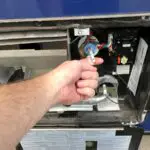
Similar Posts
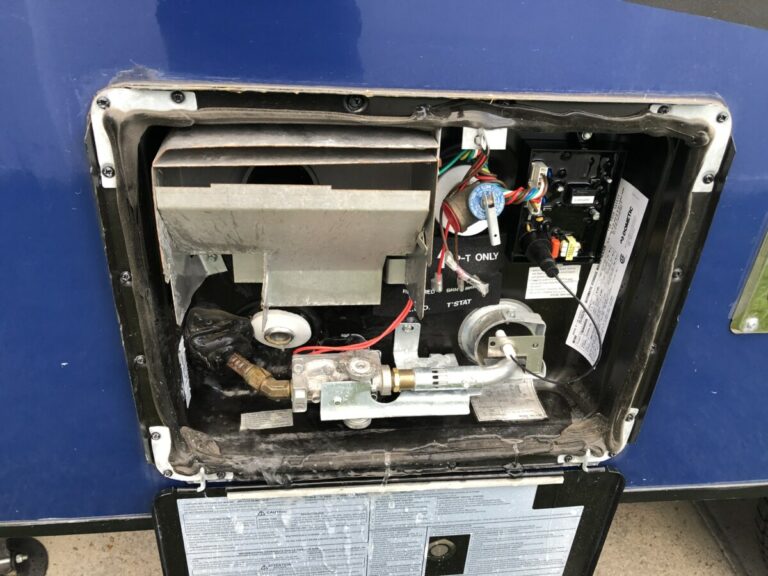
5 Essential RV Water Heater Maintenance Tips to Keep Your System Running Smoothly
RV water heaters use gas, electricity, or both, to heat water from a storage tank and deliver it to the RV’s kitchen sink, shower, etc. RV water heating devices use gas, electricity, or both. Some heathers use gas or electricity to heat the tank’s outflow pipes, while others use an electric metal element hot rod…
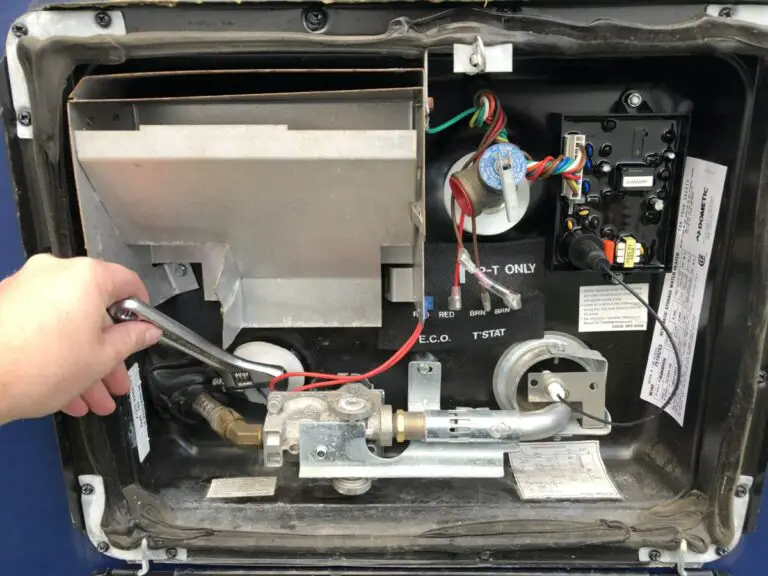
Does a RV Water Heater Run On Battery? Debunking Common Myths
Hot water in an RV is one of the essential comforts you expect when you are on the road. But the road is full of expected and unexpected adventures! Suppose you find yourself disconnected from shore power on your next RV trip. In that case, you may wonder if your RV water heater will run…
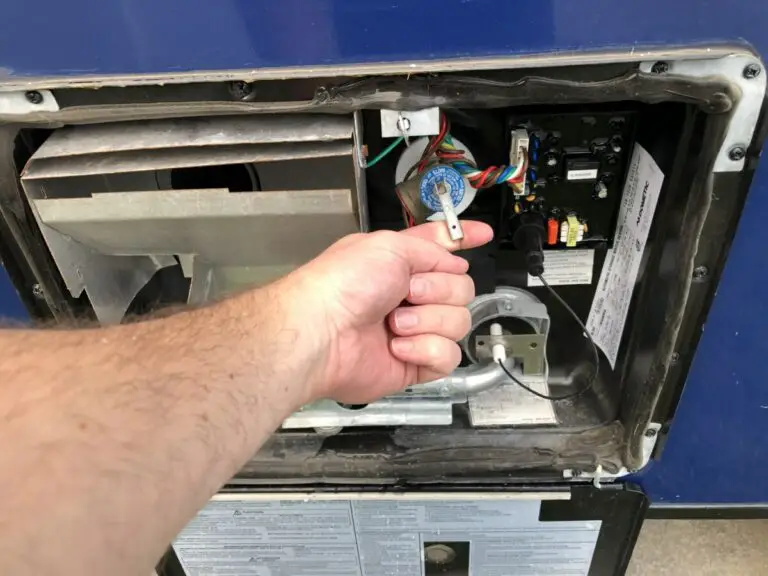
How To Drain Your RV Water Heater A Step-By-Step Guide
RV water heaters are essential to your camper or motorhome experience. Imagine your travels with no hot shower or water for cleaning. This invaluable feature needs routine care as replacing it is costly. Routinely draining your RV water heater is necessary and as straightforward as removing a plug. It clears mold, bacteria, debris, and sediment…
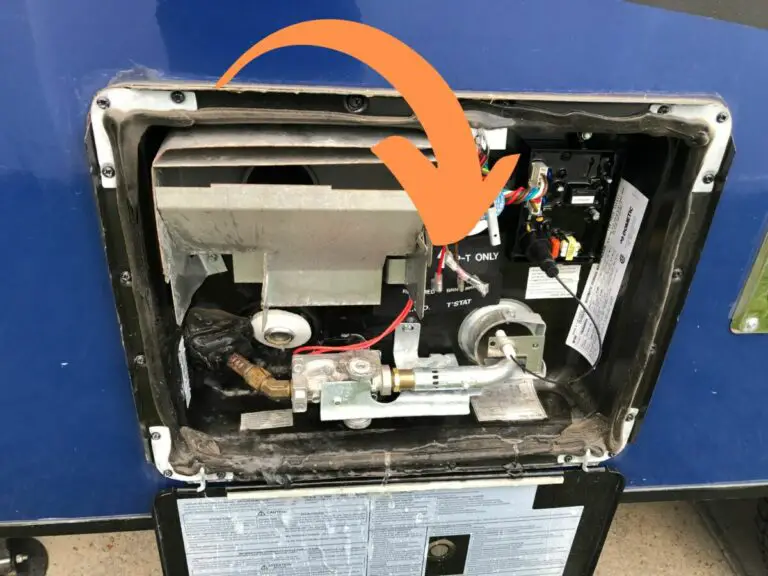
RV Water Heater Not Heating Up? How to Fix Lukewarm Water Issues in Your Camper
Let’s face it – dealing with lukewarm water on an icy cold day is not pleasant! Especially if your RV water heater is not doing its job, and getting down to the root cause feels like finding a needle in a haystack! Your RV water heater may be lukewarm because of a faulty thermostat, sediment…

13 Reasons Your RV Water Heater Keeps Tripping The Breaker: Troubleshooting & Fixes
Embarking on a road trip in your RV can be an exciting adventure, offering the freedom to explore new destinations while enjoying the comforts of home. However, a common issue that you may encounter during your journey is your RV water heater tripping the breaker. Such a problem can disrupt your plans and leave you…

How To Test RV Hot Water Heater Igniter: A Simple Step-By-Step Guide
Some RV water heaters have a dual heating system that heats the water with either electricity or gas, and other water heating systems heat the water with gas alone. The gas portion of the water heating system has an igniter that gives a spark to ignite the gas when you open a hot water tap….
Join our Newsletter to stay up to date on the latest RV topics and receive our FREE RV Inspection Cheat Sheet Today. Use this tool to inspect new or used campers you are looking at purchasing.
No thanks, I’m not interested!

SCROLL TO SITE
SCROLL TO CURRENT LIST
- Accessories
Best RV Water Heaters For 2023
Reviewed By
The home-away-from-home appeal of an RV can be greatly enhanced by hot water. Especially if a group of people are traveling together, a reliable and plentiful source of hot water for showering and dishwashing is hard to beat.
There are literally dozens of options when it comes to RV water heaters. Making the right choice involves a realistic assessment of how and where you camp, the size of your RV and how many people usually (or might) come along on a trip. Ensuring plenty of hot water for a family after a hike might mean having the largest possible water tank. It could also mean that going tankless and heating the water on-demand is the way to go.
How that water is heated is also a consideration. Should you go with electricity from the RV or is natural gas or propane a better option? Should it be a portable heater or built-in? And, as always, price is a serious factor. Here are the best RV water heater selected to meet the needs of users across five different categories.
- Camplux 5L : Best Portable Propane RV Water Heater
- Girard 2GWHAM : Best Built-In Propane RV Water Heater
- EcoSmart ECO 11 : Best Electric RV Water Heater
- Suburban Manufacturing SW12DE : Best Hybrid RV Water Heater
- EZ 101 Tankless Water Heater : Best Budget RV Water Heater
Editorial Picks

The Camplux 5L Tankless Propane Gas Water Heater is a great choice for a basic water heater for showers while off the grid. Two D-size batteries are used to ignite the propane and it comes with a five-foot gas regulator and five-foot shower head. It weighs 10 pounds and has a carrying handle built-in, so it can be mounted to the exterior of the RV or used as a portable. It can deliver 1.32 gallons of hot water per minute on-demand, with no warmup time. However, the Camplux is strictly for showering. It shuts off automatically when the water temperature reaches 176 degrees Fahrenheit, so it cannot be used to boil drinking water. A water pump is a separate purchase. Some users report unresponsive customer service.
- Battery-operated ignition
- No tank to run dry
- Peak temperature too low for boiling drinking water
- Water pump sold separately
- Not a good choice for using in near-freezing temperatures

The Girard 2GWHAM is a no-excuses RV water heater, built to last and engineered to deliver a reliable supply of hot water regardless of demand. At 42,000 BTU, the Girard heats the water quickly. It has an anti-freeze function that automatically kicks in to heat the water when the temperature drops below 37 degrees Fahrenheit. The ignition is powered by the RV’s 12-volt system. Users say it is much quieter than most propane heaters. The manufacturer recommends professional installation, but several customers say it’s an easy do-it-yourself job. A door to cover the unit is sold separately. Some users report circuit board issues that crop up over time.
- Uses less than 3 amps of power
- Quiet operation
- Professional installation recommended by manufacturer
- Door sold separately
- Some users report circuit board issues

The EcoSmart ECO 11 is a great alternative to traditional tank heaters that take up a lot of space. With 11.5x8x3.75-inch dimensions and a lightweight, wall-mounted design, it’s suitable for even the smallest of RVs. The ECO 11 provides between 1.3 and 3.1 gallons of on-demand hot water per minute, depending on the inlet water temperature. EcoSmart offers a lifetime on the product but it must be registered within 30 days of purchase and installed by a professional.
- Compact and lightweight
- Digital temperature control
- Lifetime warranty
- Not optimal for using with inlet water temperatures below 67 degrees Fahrenheit
- Not hot enough to safely boil drinking water
- Requires high amperage breaker

Flexibility and durability are the biggest selling points of the Suburban Manufacturing SW12DE. The flexibility comes from ability to operate on gas and electricity. The durability is in its construction (steel with a porcelain lining). It features a 12-gallon tank and a 12,000 BTU rating. That’s enough to heat the full tank within 30 minutes. The door and remote switch are sold separately. A 12-gallon tank takes up more space than some smaller RV owners may wish or be able to accommodate. There is no thermostat to adjust temperature.
- Gas and electric operation
- Solid construction
- Quick heating of a large amount of water
- May be too large for smaller RVs
- Door and remote switch sold separately
- No thermostat

The EZ 101 Tankless Water Heater is a propane-powered portable that has features you wouldn’t expect at this price. The ignition comes from two D-cell batteries. To conserve them and the propane supply, the propane burns when a hot water faucet is turned on and extinguishes when the faucet is turned off. A 20-minute timer automatically turns off the heater to reduce the risk of carbon monoxide poisoning if it’s being used inside the RV. Water flow and temperature are easily adjusted using three dials on the front of the unit. The on-demand heating means the unit is susceptible to freezing in cold temperatures. Some users complain that it isn’t up to the task of heating cold source water. Others have concerns about long-term reliability.
- Very reasonable price
- Built-in safety and energy-saving features
- Easy controls for water flow and temperature
- Susceptible to freezing in cold temperatures
- Some owners say it can’t adequately heat cold source water
- Long-term reliability concerns
METHODOLOGY
We evaluate all RV water heaters based on the following weighted metrics:
- Fuel source and efficiency (25%)
- Heating capacity (25%)
- Size/weight/portability (15%)
- Company reputation (15%)
- Price (10%)
- Ease of installation (5%)
- User reviews (5%)
You May Also Like
Best garage heaters for 2022, best truck toolboxes for 2022, best garage tool storage drawers and chests for 2023, best luxury trucks for 2022, best dash cams for 2023, best portable car gps navigation systems for 2023.
For partnership inquiries please reach out to us at [email protected]

- Find a Location
How To Choose an RV Water Heater

If you keep your RV long enough, the day will come when you decide to replace or upgrade your water heater. It might just be that your heater went bad after more than a decade of use. Or maybe the water heater tank froze, expanded, and cracked because you didn’t winterize your RV properly.
Maybe you just want a newer, bigger, better model. Or maybe you can’t find the right parts and accessories for a simple fix, so you’re forced to replace the entire unit. Whatever the reason, it’s good to know what types of water heaters are on the market and how to pick the right one for your RV.
A Primer on RV Water Heaters

If you don’t have any experience using RV water heaters, the first thing to know is that you won’t be able to take those long hot showers you’re accustomed to at home. The majority of models have six or 10-gallon hot water tanks. A bigger tank is typically preferable for family camping .
This also means being frugal when washing dishes. The good news is that new technology for RV water heaters provides advanced designs that increase the amount of hot water they can produce, so you can enjoy slightly longer showers and have plenty of hot water for dishes.
Some of the most popular camper water heater manufacturers include Dometic (formerly known as Atwood), Suburban, and EccoTemp. They all offer reputable products with benefits for the consumer. The main differences will lie in the construction/size of the storage tank and the method of ignition.
The Different Types of RV Water Heaters
Modern RVs are manufactured with different types of water heaters. Each type has its own features and benefits.
Propane-Only Water Heaters (LP)

The most basic type of RV water heater works on liquid propane (LP) gas. Older models required you to manually light the pilot using a long match or striker. Newer models typically come with direct spark ignition (DSI). Rather than requiring manual lighting, a switch inside your RV lights it automatically, so long as your LP gas supply is turned on and you have enough gas in your cylinder or LP tank .
Gas water heaters tend to be the most affordable replacements. They also have fewer electrical components than more advanced designs, making troubleshooting easier. Their tank capacities and recovery times — how much hot water they can produce per hour — vary depending on the make and model.
Check out this gas-only Dometic water heater.

Gas + Electric Water Heaters

This is the most common unit found in newer RVs. These models can run off LP gas or 120-volt electricity, which makes them more versatile than gas-only designs. If you’re plugged into electricity and want to conserve propane , you can utilize electricity to heat your water. But when you’re boondocking without an electrical power source, you can still heat water using your RV’s LP gas supply.
Sometimes known as combination water heaters, these units used to be available with both manual ignition and direct spark ignition (DSI). Today, most models incorporate the latter for added convenience. These water heaters typically have more BTUs to heat water faster, recover quicker, and produce more hot water per hour.
Note: Using the electric mode may limit the amount of electricity you have to run other 120-volt devices and appliances .
Check out this Dometic gas/electric water heater.
Tankless RV Water Heaters

Tankless water heaters, also known as on-demand water heaters, are the most energy-efficient models on the market right now. This is because the LP gas-fired heat exchanger only heats the water when there is a demand.
Plus, they can deliver continuous and nearly endless access to hot water, so long as you have water in your freshwater tank or you’re connected to a water source. It’s the closest you can get to a residential or commercial water heater. You don’t have to worry about manual ignition or DSI. You open the hot water faucet and mix in the cold to get the desired temperature.
Learn more about this Girard tankless water heater.
Because of their added features and convenience, tankless water heaters tend to be the most expensive of these three types. They require more complex maintenance than the other designs and are more sensitive to lower water pressures, which is why many employ a pressure regulator along with this heater style.
Check out this Excel Vent-Free tankless water heater.
Portable Heat Pump Water Heaters

Due to the popularity of small campers and camper vans these days, several manufacturers have come out with portable water heaters. They are designed for outdoor use and are typically fueled by propane or an electrical component — some models have both.
They also include a pump element to supply water pressure to a connected hose. They’re ideal for RVs that don’t have their own built-in water heating element, and they’re relatively inexpensive. But you’ll need to have the storage space inside your RV to keep it safe between uses.
See the specs for this Eccotemp portable tankless water heater.
Tips for Maintaining Your RV Water Heater

Regardless of which type you choose, following these tips will help you get the most out of your RV water heater:
- Use an RV water filter . This minimizes the potentially corrosive chemicals and particles that enter your RV’s water system. Learn more about sanitizing your RV’s freshwater system .
- Inspect your anode rod regularly. Not all models come with an anode rod, but it’s an important component for corrosion and build-up prevention in those that do. Inspect it regularly according to your heater’s owner’s manual.
- Adjust it to your desired temperature. Your owner’s manual will have specific instructions, but you can adjust your water heater to heat to your desired temperature.
- Drain your hot water tank in the winter. While winterizing your RV, drain your hot water tank completely to avoid damage from leftover water freezing and expanding.
- Inspect the heater tube when de-winterizing your RV . When your RV has been in storage, insects and small critters can build nests in your heater tube. Inspect and clean it out if necessary before firing up your heater for a new camping season.
Most of these water heaters can be installed in existing water heater openings with minimal modification. However, you should still talk to the service folks at your local Camping World SuperCenter store about replacing your existing water heater with an upgraded model to ensure you find a compatible unit and install it properly.
Do you have any other questions about RV water heaters? Leave a comment below!
- Comment (14)
Does camping world install water heater at my location? I’m living in it. Impossible to move. It came with an Atwood and of course it’s gas/ electric. Is there more Brands available? Im living on a very small budget and can only spend so much. Thank you so much for your time and help. Sherry Roberts

Some of our service centers offer mobile repair, so I’d recommend reaching out to your local Camping World to inquire: https://rv.campingworld.com/locations
In addition to Atwood, which is actually now Dometic, other popular water heater brands include Suburban and Girard. You can explore our water heater selection here: https://www.campingworld.com/maintain-rv/fresh-water/rv-water-heaters
Hope this helps!
I have a 94 holiday Rambler and the water heater is pouring water out of the release valve. I know it needs to be replaced. My question is are water heaters universal or are there specific ones that go to certain model trailers? Also mine is LP gas and electric, Can I go straight electric?
If you do not do any primitive camping, you can go that route, but the cost diff. isn’t enough to worry about. Most generally speaking, you will have propane usage in your camper anyway.
I have a 2003 Cougar 5th wheel trailer and the water heater ( 6 gallon ) is leaking badly but before the t valve on back tank broke I could have water to trailer by turning off water heater but replaced valve and now leaks all the time what is the best option replacing it with same kind or going to on demand water heater
Nothing wrong with going on demand, as I have one for a backup, but I like the versatility of gas and electric. When the unit goes down a backup on demand is nice.
I replaced my standard water heater with a tankless it works great! However when dry camping if you turn off the water flow you turn off the water heater at the same time. The water heater takes up to one gallon of water about 30 seconds of cold water every time you shut the water off to try to conserve water not really working. I use more fresh water and wast water tank space.
I purchased a tankless on demand water heater. When it didn’t work properly, I had them send me a second one. Neither worked. I paid $200, so maybe that is what you get for $200. Someone else in the camp grounds had the same trouble with theirs. The trouble we had was, the hot water shuts off for no reason at all…and always when you step in the shower. I had many people looking at it with me. I swore it had a naked skin sensor because it would work fine until I got naked and wet. Shutting the water off and turning it back on would get it going again. Both are going in the junk pile. Looking for an electric tank heater, which is how I came across this site.
Not having a water supply issue is supposedly why tankless is so lovely, much like home use. But they are also excellent when in a pinch. You already own it, so have it plumbed as a standalone unit and just carry it as a backup. Propane and elect. The combo is an excellent way to go. Gen speaking, when one goes out, you have the other, and when in a camp, they supply elec., but if ever ending up primitive, there is that choice too! If you never use the on-demand, sell it later.
Can you replace a tankless with a more conventional water heater?
There should be no reason you can’t. The only difference is you will have water to heat up for use. But limited to the water tank’s capacity. I would get the most significant ability to warm up the water. It may pay to have a service professional install the new HW Tank system unless you know exactly how to install it and not cause leaks or wiring issues.
Anthony, you should call your local dealership and discuss this with them. They will be able to steer you in the right direction.
Temperature is set to high
My wife MUST have long hot showers. Went tankless and have never regretted it. There is however a learning curse for its use. You must have good water pressure. The most you can stand. If you feel you must have a regulator on your water supply make sure it’s a 50 psi. Turn on hot then add cold to adjust.
Leave Your Comment Cancel Reply
Save my name, email, and website in this browser for the next time I comment.
Shop By RV Type

Your Adventure Awaits
Copyright © 2023 cwi, llc all rights reserved.
- RV Glossary |
- Privacy Policy |
- California Privacy Rights |
- Do Not Sell or Share My Personal Information |
- Targeted Advertising Opt Out |
- Terms of Use
“Where’s the Hot Water?”
Troubleshooting common hot water heater problems.
by Jessica Rider
December 18, 2023
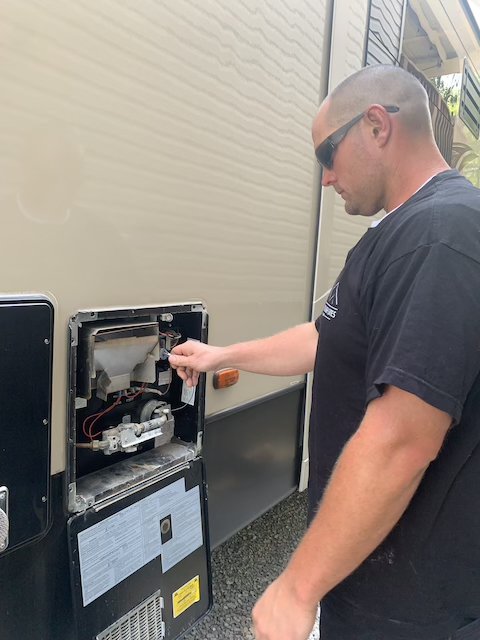
Pullthroughsites.com
Regular inspections and servicing may save an expensive repair bill.
One of the main reasons we moved from tent life to RV life ten years ago was for the added comfort, including having hot water. There is nothing like a steaming shower after hiking the amazing trails of Canada.
As cold weather becomes more prevalent across regions of North America, the more our mobile RV repair service business receives calls to address hot water heater problems. We frequently help with troubleshooting, complete repairs, and educate our customers about best practices.
Common Problems, Failures and Causes
A common complaint among RVers is that a water heater is not producing hot water. To better diagnose the problem, we first ask if the system is operated by propane or power. If they are using power, we suggest switching the system to propane, if applicable, and vice versa. This narrows down a solution for our technicians and may even be a simple fix to save a repair bill.
Many systems in an RV, water heaters included, operate within a chain of other systems. For instance, when you flip the switch on the water heater - whether by electricity or propane - it signals the control board on the heater, which provides operation.
When we can’t immediately solve the problem, we inspect the control board to determine if a signal is coming in and going out that either triggers the ignitor for propane or to signal for electric heat. In simpler terms, when hot water is not being produced, the cause may be a faulty switch or ignitor, which can be replaced.
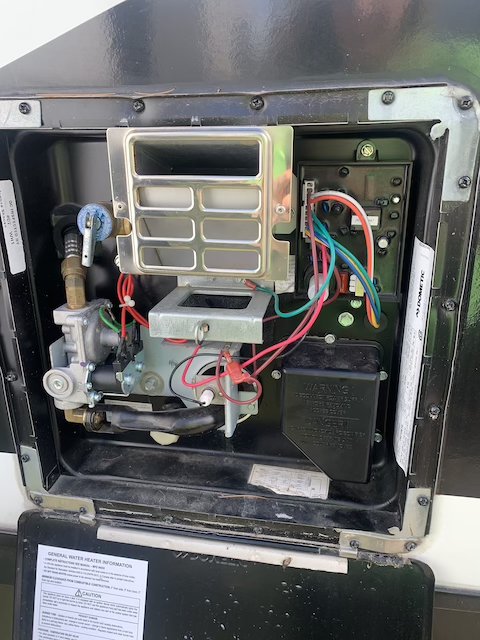
Repairs and Costs
Replacing an ignitor or a switch is relatively inexpensive and may cost less than $100. However, we have seen the actual control board breakdown, which can be between $100 and $200. It’s still reasonable given the cost of an RV hot water heater but repair bills can quickly increase when there are multiple problems.
For example, if a hot water tank needs to be replaced, it can be upwards of $1,000 or more. Modifications may also have to be made to properly accommodate your RV like Installing an electrical outlet or fitting in a new access door, resulting in additional costs.
Best Practices
We encourage RVers to understand how a water heater works and ensure there are adequate amounts of propane or power. Also, if water is leaking in the area of the heater, there’s a 90 percent chance there’s a leak in the tank and needs to be replaced. One best practice we always suggest is to winterize a motorhome or trailer properly. We have replaced many tanks with cracks caused by improper winter storage.
RV hot water heaters are not sophisticated. By understanding how they operate, ensuring proper winter storage, and doing maintenance when needed, you’ll always have hot water when you need it.
All content is Copyright SunCruiser Publishing Inc. but we do like to share. If you would like to use content from our site, please contact us at 1-866-609-2383.

Home » Heating, Cooling and Ventilation » Can I Replace My RV Water Heater With A Tankless Heater?
Can I Replace My RV Water Heater With A Tankless Heater?
RV Expeditioners may collect a share of sales or other compensation from the links on this page. This comes at no additional cost to you, and all the prices and availability are accurate at the time of publishing.
A tankless heating system is very attractive to most motorhome owners. Instead of keeping hot water in a tank, a tankless system heats up the water as needed.
It has the potential to help you save money on heating costs and it can also guarantee more hot water uptime than a standard water heater tank assembly.
Suggested read: What are the Best RV Tankless Water Heaters?
But what if you already have a water heater installed in your RV? If you’re asking yourself can I replace my RV water heater with a tankless system, the answer is yes, and, this article will guide you through the process.
Because they work entirely different from one another, a regular RV water heater can’t be converted to a tankless system. It can however be replaced for one.
This can be done as a DIY project, but it’s not advisable if you don’t have all the tools and the technical know-how.
What You Need to Know
Here are a couple of things about tankless heating systems that you have to know before making your standard water heater tankless.
Water Usage
Choosing a tankless system involves first calculating your water usage. This means taking into account the toilet, shower, sink, dishwasher, etc. Think about how often you’ll use those amenities and appliances to figure out how powerful the tankless heater should be.
You may find heaters that can work up to 6 gallons per minute, which is a lot for any RV. But even then, the water temperature may not be constant.
This is why regardless of how powerful the tankless heater system is, it’s recommended that you only use one appliance or outlet at a time for constant hot water temperature.
Electric or Gas
Propane or natural gas-powered tankless water heaters are usually the best choices for mobile homes. Electric tankless heaters are less efficient and may not be practical for an RV. These things draw a ton of power.
You can install a tankless water heater on the inside or on the outside of your RV. But, if you choose to put it on the outside, remember that you will also need an anti-freeze kit for winter time. Also, in some states, there may be regulations in regard to ventilation.
When you’re talking about replacing a standard water heater with a tankless system, you need to start adding up certain costs. Tankless systems may be more efficient and long-lasting, but they have a high initial cost. On top of that, you have to add fuel costs and the installation cost.
The installation alone can cost you hundreds of dollars on top of the tankless system itself. That’s because there are many modifications to be made (electrical panel, gas lines, plumbing) and you’ll likely also need a separate ventilation system.
Last but not least, tankless heaters require more maintenance year-round, but you can cut that down if you install an interior tankless water heater system.
Pros and Cons of Converting to a Tankless Heating System
On-demand heating is the main benefit of getting rid of your standard RV heating system in favor of a tankless solution. It’s especially beneficial when you have a limited water supply.
Longevity is also a nice perk. Most tankless heating systems can last up to 20 years. That’s nearly double the shelf life of most RV tank-based water heaters.
Last but not least, having access to a continuous supply of hot water, whenever possible, takes motorhome living to another level.
But, it’s not all perfect. Replacing your standard water heater is expensive since tankless systems can be up to 80% more expensive than a tank water heater.
This takes into account the additional installation costs.
In regards to installation, there are many things to worry about. You need knowledge of how to work with gas lines and plumbing, not to mention that in some states a dedicated venting system may be required by law.
You have to accept that you may not be able to install a tankless system without professional help. But, you might be able to save some of the installation cost by removing your existing water heater first.
Final Thoughts
Not all RV owners will benefit equally from a tankless water heater. If you just use your RV for recreational purposes, then you may not have a permanent hookup to gas lines. This means that an electrical tankless water heater assembly is required.
For those who only spend weekends or holidays in the motorhome, investing in a power-hungry electric tankless water heater may not be worth it if you don’t already have a high-end power bank.
On the other hand, if you’ve adopted the RV lifestyle, and you’ve made your RV your permanent residence, then a tankless system becomes worth considering. If you have access to a gas hookup and an unlimited water supply, a tankless system can increase the level of comfort tenfold.
Sharing is caring!
Leave a Comment Cancel reply

- You are here:
- Home »
- Blog »
- RV Water Heater
- » Finding an Atwood G6A-8E Water Heater Replacement (Guide)
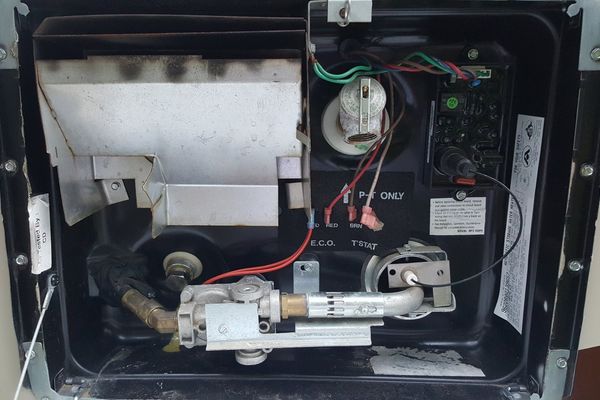
Finding an Atwood G6A-8E Water Heater Replacement (Guide)
- May 12, 2023 /
- RV Water Heater /
- By James V.
Everyone needs hot water. It is one of the most important tools to use to relax. A nice hot bath or shower after a hard day of work gets those muscles back where they should be. Plus, the hot water can rejuvenate you so you are ready for the night’s activities.
Finding an Atwood water heater replacement is as easy as going to an RV parts and accessories store and buying a new one. There are some of these models still being sold today, you just need to know where to look. Amazon has had it.
To learn more about finding a replacement for this model of water heater, just continue to read our article. It has the information you want to know about so you can pick up a replacement quickly. It is just a matter of knowing where they are and how much they will cost you.
Atwood G6A-8E Water Heater Replacement Options
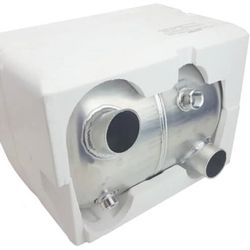
RV water systems were the first result that popped up in our search. They have been advertising a brand new Atwood G6A-8E 6-gallon water heater on one of their web pages. You can find the ad at this link .
However, if that is old news and those water heaters are not being made anymore you can try e-trailer. They suggest either the Furrion RV Tankless Water Heater Item # FR98SR or the Atwood # DMC74FR.
The latter option may need some door adaption to make it fit the current space in your RV. If you own an airstream trailer, it seems there is a replacement available. This is what the company said when they were asked this question:
“ According to our records, this unit is still available. This can be ordered through any authorized Airstream dealer using part number 690199. I have included a link below to our dealer locator.
https://www.airstream.com/dealers/” ( source )
To be honest, a tankless water heater may be better to install than another tank water heater. The only issue will be space as it is with replacement options for this water heater model.
It is something to consider if you cannot find any 6-gallon water heaters available at this time.
G6A-8E Water Heater Replacement Tank
Amazon can be disappointing at times. The company will appear in many product searches and when you click on their link, you find that the product is unavailable. This marketplace would be an option for this part but they are currently unavailable at this time.
RV Upgrade’s an online RV parts and accessories outlet has a tank they will ship to you. The purchase price is just under $300 but unfortunately, they are out of stock as well.
Detroit Hitch company is advertising that they have some, whether it is in stock or not is another question. They have listed several models in a box on their web page and here is the number for this model of water heater- 429-1641 INNER TANK E 91641.
According to the web page, this model is supposed to fit these water heater models- E- Fits (G6A-4E, G6A-6E, G6A-7E, G6A-8E, G9-EXT). You can view the web page at this link .
A local search for your area may turn up more options and be closer to you. You may find a better price as well. We will warn you that the Detroit Hitch website is only copyrighted to 2016 so they may not be in business anymore.
We did find one company with an up-to-date website selling this model of water heater for $350. It is a little more expensive than other outlets but in a pinch, it will do. Click here to see it.
As you know, shipping and handling charges will vary depending on your location.
Atwood G6A-8E Dimensions
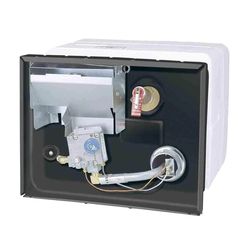
The dimensions for this water heater are 12.5" H x 16" W x 17" D and that is going to make it very difficult to find a replacement if this model is no longer available. Most replacement suggestions are bigger than that and you would have to make some cuts to your RV to get them to fit.
The Furrion tankless water heater we mentioned earlier has dimensions close to that- 12-5/8" H x 12-13/16" W x 19-3/16". But that 2-inch depth difference may cause some installation problems.
Camping World is selling a 6-gallon water heater made by Atwood at this time. It is a clearance sale and there is no telling how long supplies will last. The company does not place too much information about it online but it is possible it will be close to the dimensions of the G6A-8E model.
If you are having trouble finding the Atwood G6A-8E SP water heater, it may be because it is sold under another model number. That number is Atwood 96121.
The price at one outlet, a marine one, is not encouraging as they are selling it for $600. That is the sale price. The regular price is roughly $640.
Girard Tankless RV Water Heater To Replace Atwood G6A-8E
It is possible to do this project. One owner has done it even though the Girard model cost just over $700 and was smaller than the Atwood G6A-8E. He did have to install a new door at the cost of roughly $53.
He has documented his transition and you can see the pictures and get all the details at this link . It is kind of hard to read due to the lack of paragraphs, the background color, and the font size.
Moving to a tankless water heater has its benefits. You get unlimited hot water so everyone can shower as well as do the dishes and clean up messes. There is no delay in receiving hot water with a tankless version and you do not have to worry about traditional water heater parts.
While the purchase price may be higher for one of those tankless heaters, you may save enough over time and use it to cover that extra expense. It certainly is worth considering.
They also take the worry out of having hot water. With fewer parts to go bad, these tankless options should save you even more.
Finding an Atwood G6A-8E Water Heater For Sale
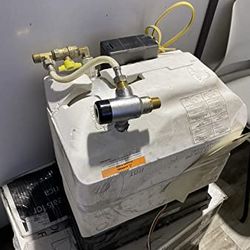
We are finding them for sale. We listed a couple of places above that may be out of stock at this time or out of date but there are RV parts and accessories outlets that seem to have this model in stock. You may pay a little more but at least you can find them at the 2 locations we already mentioned.
Other places to look would be the classified ads if you are willing to go with a used model. Or you can try the various RV discussion forums. Those websites often have a classified section where RVers can sell just about anything RV related.
If there are none for sale when you check, the members may know of some stores that have them on sale. Or you can try eBay as you never know when one of those vendors place one for sale on that marketplace.
Besides the online outlets that cater to the RV world, you can also contact Dometic, the owner of Atwood, to see if they have any water heater tanks for sale.
The drawback to contacting Dometic is that they may not be allowed to sell directly to the public. If they have an online store, they are allowed. Ny water heater dealer that is approved by Dometic will also be able to help you in your search.
Download The Atwood G6A-8E Manual
As you know, the Manuals Lib website is our go-to download manual website. They do not disappoint as they have listed this water heater model as well. The biggest drawback to this website is that they do seem to charge for downloading their copies.
Another website to try is tech support. This link will take you to their Atwood G6A-8E manual web page. We do not know if they charge a fee or not. Sometimes you do not find out till you send the purchase order to your checkout.
Then one more outside website for manuals. All Guides has a good selection including this Atwood model. You can check to see if they charge anything when you click on the manual you want.
Finally, you can contact Dometic directly and see what manuals they have available. Since Dometic took over Atwood, this may not be the best option unless nothing else works for you.
Usually, manufacturers allow you to download it for free. We are not sure if this company does that or not.
Atwood G6A-8E Wiring Diagram
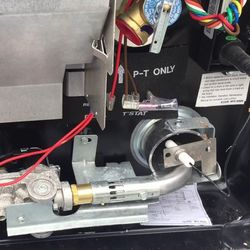
There is a small wiring schematic on page 12 of the manual for this water heater model. But unfortunately, the Manual Lib website does not allow copying images anymore. Here is one wiring diagram from a shorter manual from All Guides:
There are other diagrams available from the All Guides link above. They may help and they may not. It all depends on your needs. You may know that search engines post a section called images.
Under that category, when you do this search, you will find hundreds of possible wiring diagrams. Match them up with this one to be sure you are getting the right diagram.
Not all images and diagrams that appear there will be actual wiring diagrams for this Atwood water heater. If in doubt, contact Dometic or one of their dealers to see if they have the proper wiring diagram.
Sometimes they will issue them to customers and sometimes companies do not.
How Much Do Tankless Water Heaters Cost?
We have talked about a couple of these models as possible replacements for your Atwood G6A-8E model. It is a good possibility. Considering that you are looking at paying anywhere between $300 and $600 for a new Atwood, these tankless models may be more economical than thought.
The cost of the cheaper versions runs about $100 to $200. But these do not heat up a lot of water at one time. Maybe 1.5 gallons per minute which is not enough to do more than heat your shower.
To get a better quality tankless water heater, you may have to pay as much as $1000. These models will heat very quickly and allow you to shower and wash dishes at the same time. Most of these models will cost between $500 and $1000.
Even though tankless water is gaining in popularity, they are not standard equipment on most RVs. They would be a piece of optional equipment that would boost your RV purchase price.
If You Can’t Find a Traditional Water Heater Replacement
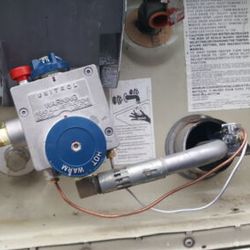
In our research, it seems that finding a new Atwood G6A-8E water heater is getting harder to do. Even the recommended replacements are larger than this model causing some installation issues.
As you saw, one outlet was dated to 2016 but the price for the water heater was attractive if still available. However, a tankless water heater takes up less space, weighs less, and works longer than the Atwood G6A-8E model.
That makes those options very attractive. What doesn't make them attractive is that you can use more water with one of these replacements and a little more electricity.
It is a judgment call and one worth considering given the convenience they provide when your RV is full of people all needing showers.
Some Additional Words
It is hard to say what is happening with Atwood products. Once Dometic took over the Atwood name remained on many RV items. But that seems to be disappearing.
When Dometic bought Atwood in 2014, a lot of rebranding took place. Atwood products are being sold under the Dometic brand name. That makes it hard to find replacements for different Atwood products.
If you want a direct replacement for this water heater model, you should look to Dometic water heaters. They are basically the same type of appliance, just marketed under a new name. The model numbers may have changed as well.
Related Posts
Tank Capacity: How Much Water Does an RV Hot Water Tank Hold?
Forest River Water Heater Operation Guide (How To Turn On)
Forest River RV Hot Water Heater Not Working (Troubleshooting)
Leave a Comment:

How Much Does It Cost to Replace a Hot Water Heater?
R eplacing this household essential can throw a wrench in your budget if you don't plan for it. Learn how much it costs to replace a water heater.
A hot water heater is an essential home appliance that lasts an average of 8 to 12 years before it needs to be replaced. However, the life span can vary widely depending on appliance type, capacity, energy source, and maintenance schedule.
So, how much does it cost to replace a water heater ? The total price for each household depends on the type and size of the heater, fuel source, labor costs, the location of the water heater, and permits and inspections. Here’s what you need to know to determine how much it costs to replace a water heater, including important pricing factors and money-saving tips .
Related: Gas vs. Electric Water Heater: How to Choose the Right One for Your Home
Hot Water Heater Replacement Costs
“The average cost for a water heater replacement ranges from $600 to $3,500, with tank-style water heaters priced between $600 to $2,500, and tankless water heaters from $1,200 to $3,500,” says Danny Margagliano , a real estate agent and co-owner of a home improvement website. However, additional expenses may include permits, labor, and additional venting systems needed for proper installation.
Several factors influence the replacement costs of water heaters. The critical cost components include:
Type of Water Heater
The two major types of water heaters are tank and tankless, and both have their pros and cons. For example, a tank-style water heater is a traditional option. It stores anywhere from 20 to 100 gallons at a time and constantly heats the water, even when it’s not in use. These typically cost between $600–$2,500 to replace.
Tankless water heaters don’t have a water storage tank and provide warm water on demand. They are efficient because they only heat water when you need it, but it can take a few minutes for the water to reach the desired high temperature. These are ideal for compact spaces. However, high-end tankless models can cost twice as much as conventional tank-style water heaters. Tankless water heaters typically cost between $1,200–$3,500 to replace.
Related: The 9 Best Tankless Water Heaters of 2024
Water Heater Size
The size of a tank-style water heater is measured in gallons, while the tankless type is measured in gallons per minute. The larger the tank or the more gallons per minute, the higher the cost. The appropriate water heater size for your home depends on the number of people in your household and the demand for hot water. For example, for a three-person household, a 40–50 gallon tank or a 3-5 gallons per minute tankless model would be ideal.
While you might consider purchasing a larger unit, it may not be the smartest financial move. A unit that is too big is not cost-effective because running it may cost you more in utility fees than necessary over its life span.
Fuel Source
Different fuel sources for water heaters include electricity, natural gas, propane, and solar power. Installing electric, natural gas, or propane water heaters may range between $600 and $3,500. Solar water heaters generally cost between $1,700 and $5,000, but the final cost can go as high as $13,000+ for large homes.
If you plan to switch between gas and electric models, it may cost an additional $300–$1,500 to install gas lines or $500–$1,000 for electric lines.
Ventilation System
While electric water heaters typically don’t need venting, gas or propane ones do. The two types of venting systems are direct and power. Direct vent heaters use an exhaust pipe or chimney to exhaust gas directly outside your home. Power vent heaters use a fan or blower. “Venting system installations cost an additional $300 to $600,” estimates Margagliano.
Parts and Materials
Replacing a water heater includes minor items you may not have considered, such as discharge pipes, pressure release valves, and connectors. If you convert from tank-style to tankless or from electric to gas, more materials and parts may be needed to get the job done.
Labor costs for water heater replacement range from $50 to $150 per hour. “Labor accounts for 50 percent of the budget,” Margagliano says. The labor costs vary based on the scope of work, the time needed to complete the job, where you live, and the installer’s experience level. Experienced contractors tend to charge more.
Another consideration is the location of the water heater in your home. If it is located in a hard-to-reach place, like a tight closet, crawl space, or basement, the labor costs will be higher because of the skill and time needed to complete the replacement job. Other expenses could include the removal and disposal of an old water heater , additional handy work (drywall installations, wall framing, new gas line installation), and expansion tank installation.
Permits and Inspection
Some local building codes require homeowners to get permits before replacing water heaters. These can be as little as $25 in some places, but expect a bigger bill when switching between fuel sources. Many municipalities require verification from a city building inspector to ensure the installation was done correctly.
Tips for Saving on a Water Heater Replacement
One way to save costs is to replace your old model with the same type of water heater. Another is to choose a brand that gives you value for money. For example, opt for a mid-range model with the same features instead of a high-end brand with more bells and whistles you may not use. Also, research deals and discounts from the manufacturer and retailer. Last, think about utility efficiency. Some models are more energy- or water-efficient, so they may be worth a higher upfront cost.
Related: How to Pick a Money-Saving Water Heater Replacement
What to Consider Before Replacing a Water Heater
Trying to get the most you can from your current water heater makes sense. Repairs usually cost less than replacement. So, if your model is less than ten years old, you may want to invest in minor repairs and maintenance to prolong the life of your existing model. For example, if your area is prone to hard water, try a water softener and replace any internal rods that might have been damaged. This may give you a few more years of life on your current model while you save up for the eventual replacement.
Before buying a one-for-one replacement, seek help from a professional to determine the appropriate heater type, capacity, unit size, and ideal fuel source for your current needs. New heaters may offer efficiencies that were not available when you bought the last one.
Related: How to Flush a Water Heater
For more Better Homes & Gardens news, make sure to sign up for our newsletter!
Read the original article on Better Homes & Gardens .
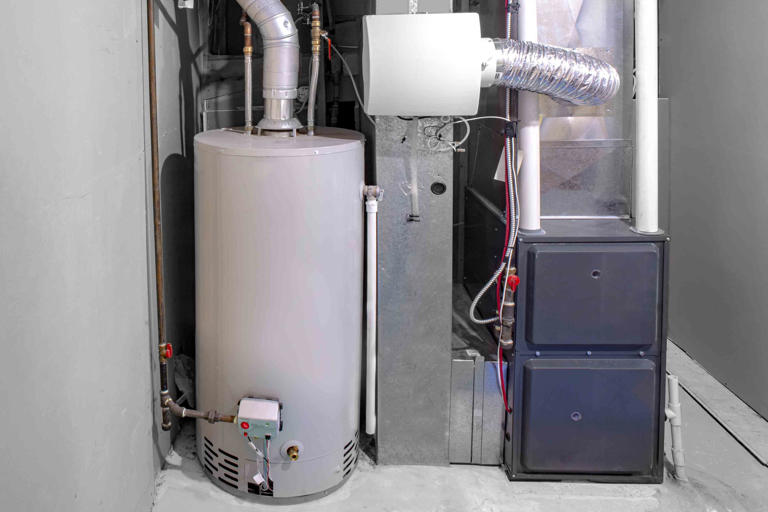
10801 Starkey Rd Suit 104-301, Seminole, FL 33777
Follow Us on

Military, Veterans, & First Responders Discounts
RV Hot Water Heater Maintenance Tips
Tips and reasons to call for mobile rv repair for hot water heaters.
Welcome, fellow RV enthusiasts! Embarking on the open road with your home-on-wheels is an exhilarating experience. Amid the excitement, ensuring your RV’s water heater is in top-notch condition is crucial for a comfortable journey.
In this comprehensive guide, we’ll explore essential tips for maintaining RV hot water heaters and discuss why calling for mobile RV repair is your go-to solution when issues arise. Let’s dive into the intricacies of RV water heater maintenance , ensuring a worry-free travel experience.
Understanding the Basics of RV Water Heaters
Your RV’s water heater is a multifaceted system designed to provide hot water for various purposes, from refreshing showers to dishwashing. Most RV water heaters operate on a dual system, utilizing both propane gas and electricity, offering flexibility during your travels. Key components include the tank, heating element, relief valve, anode rod, and other integral parts that collectively contribute to the heater’s efficient functionality.
Essential RV Hot Water Heater Maintenance Tips
Regularly check the anode rod.
The sacrificial anode rod is a crucial component that prevents corrosion within the water heater tank. An annual inspection is recommended, and replacement is necessary if the rod is more than 75% corroded. This simple step significantly extends the lifespan of your water heater.
Flush the Tank
Sediment buildup is a common issue affecting the efficiency of RV water heaters. To mitigate this, drain the tank by removing the drain plug and thoroughly flushing it out. Conducting this procedure at least once a year ensures optimal performance.
Inspect the Bypass Valve
The bypass valve is essential during the winterizing process. Ensure it is set correctly to prevent freezing and potential damage. Refer to your owner’s manual for guidance on the appropriate bypass valve positions.
Check for Leaks
Regularly inspect the water heater for any signs of leaks, especially around fittings and connections. Addressing leaks promptly is crucial to preventing water damage to your RV.
Examine the Heating Element
If your water heater isn’t functioning properly, the heating element may be the culprit. Periodically check for signs of corrosion or damage and replace the element as needed. Regular testing helps identify issues before they escalate.
Test the Pressure Relief Valve
Lift the pressure relief valve lever to ensure it operates smoothly. If the valve fails to function correctly or water continues to flow afterward, consider replacing the valve to maintain optimal safety levels.
Monitor Water Flow and Pressure
Inconsistent water flow or pressure may indicate underlying issues within the water heater. Address any irregularities promptly to avoid inconvenience during your travels.
Why Call for Mobile RV Repair
Despite diligent maintenance, RV water heaters can encounter unexpected issues. When faced with problems such as the water heater not staying lit, insufficient hot water, or other common issues, calling for mobile RV repair becomes a pivotal solution.
Benefits of Mobile RV Repair Services
Convenience.
Mobile RV repair eliminates the need to tow your RV to a repair shop. This convenience is especially valuable when dealing with water heater issues, ensuring uninterrupted access to hot water during the repair process.
Expertise in RV Systems
Mobile RV repair technicians possess in-depth knowledge of RV systems, including water heaters. Their expertise guarantees a thorough diagnosis and an effective resolution of the issue, saving you time and hassle.
Prompt Response
Time is of the essence when dealing with water heater problems. Mobile RV repair offers swift response times, minimizing downtime during your travels and ensuring a prompt resolution to your water heater concerns.
Comprehensive Repairs
From addressing issues with propane and electricity supply to fixing heating element problems, Mobile RV repair offers comprehensive solutions. Their expertise extends to various water heater issues, providing a one-stop solution for your RV maintenance needs.
Contact AA Mobile RV Repair for Mobile RV Water Heater Maintenance and Repairs
Maintaining your RV’s hot water heater is a pivotal aspect of ensuring a seamless and enjoyable travel experience. By adhering to these maintenance tips and recognizing when to call for mobile RV repair, you can guarantee that your water heater remains in top-notch condition, providing you with the comfort of hot water wherever your adventures take you. Here’s to happy and worry-free travels!

IMAGES
VIDEO
COMMENTS
My RV Works, Inc., certified RV Technician, Darren Koepp is on-site to replace a customer's Atwood water heater. Watch as Darren does a 1:1 swap from a 6-gal...
Additional Advantages: Longer lasting, residential style porcelain lined steel tank. Repositionable module board provides installation flexibility. Backed by a 2 year limited warranty and the tank is backed by a 3 year tank limited warranty - the best in the RV industry. Assembled in the USA by Suburban, the leader in RV water heaters.
Step eight, remove any silicone from the top of the water heater. Step nine, bend the control housing mounting flange 90 degrees forward and start removing the water heater from the cutout in the RV. With the water heater halfway out, disconnect any electrical connections. Remove the old water heater. Step ten, remove the inlet and outlet 90 ...
Replacing a Suburban 6 gallon propane/electric water heater in our fifth wheel
The main manufacturers of tank-based RV water heaters are Atwood and Suburban. The tanks of RV water heaters are much smaller than those of home water heaters. A small home heater is 40 or 50 gallons, but as mentioned above, an RV water heater maybe just six or 10. This means that you need to be more conservation-minded when using hot water in ...
Turn the valve clockwise to OFF to shut off water to the entire RV. With power and water supply halted, the old unit can now be drained and disconnected safely. Step 3. Drain the Old Water Heater. Before removing the old RV water heater, its tank must be fully drained to prevent any remaining hot water from spilling out.
Suburban 5243A Electric Water Heater With Direct Spark Ignition - 10 Gallon. The Suburban 5243A is a gas/electric hybrid RV water heater, which gives you flexibility and options when you're going off-grid or when you run out of gas. The 10-gallon capacity gives you between an 8- and 10-minute hot shower (depending on how cold the water is ...
️ About the Episode:This is a complete How-To video on RV Water Heater Troubleshooting, Repairs, and Maintenance. We start with some top RV Water Heater Que...
Step 2: Locate The Thermocouple. The RV Water Heater Thermocouple is located behind burner. The first thing to do is test the thermocouple's resistance. Locate the thermocouple attached to the plate next to the pilot light. It should look like a metal rod that extends into the flame.
Hide Summary. Camplux 5L : Best Portable Propane RV Water Heater. Girard 2GWHAM : Best Built-In Propane RV Water Heater. EcoSmart ECO 11 : Best Electric RV Water Heater. Suburban Manufacturing ...
Tanked RV water heaters generally have a 6 to 10-gallon capacity. Most commonly, standard RV water heaters have been supplied to RV manufacturers by one of two companies. * PRO TIP: When we had a standard 2-way unit, and wanted hot water as quickly as possible after arriving at a campground, we used BOTH modes.
This RV water heater uses an automatic direct-spark gas pilot and an internal electric heating element to get hot water ready fast. Recovers up to 12 gallons of water per hour. Unit is small and lightweight for an easy fit in your RV's cabinet. Great Prices for the best rv water heaters from Dometic. Dometic RV Water Heater - Gas and Electric - Automatic Pilot - 120 Volt - 10,000 Btu - 6 Gal ...
The most basic type of RV water heater works on liquid propane (LP) gas. Older models required you to manually light the pilot using a long match or striker. Newer models typically come with direct spark ignition (DSI). Rather than requiring manual lighting, a switch inside your RV lights it automatically, so long as your LP gas supply is ...
Discover the essential guide to addressing RV hot water heater problems. Learn common issues, effective troubleshooting tips, and cost-effective repair solutions. Our expert mobile RV repair service shares insights on diagnosing failures, replacing components, and maintaining best practices to ensure your comfort on the road. Whether it's a faulty switch, ignitor, or control board breakdown ...
🚐💧Is your travel trailer water heater not working? Don't let a faulty heater put a damper on your adventures! Join DOUGandNIKI as we show you the ultimate...
Costs. When you're talking about replacing a standard water heater with a tankless system, you need to start adding up certain costs. Tankless systems may be more efficient and long-lasting, but they have a high initial cost. On top of that, you have to add fuel costs and the installation cost. The installation alone can cost you hundreds of ...
Pro Tip: Portable water heaters are almost an entirely separate category of RV water heaters. Check out some comparable models here. #6. Bosch Electric Mini-Tank Water Heater. If you want a mini-tank option to save space, try this Bosch water heater that conveniently fits on a shelf, wall, or floor.
2) How to Replace an RV Water Heater Thermostat. 2.1) Turn Off the Water Heater. 2.2) Remove the Thermostat Cover. 2.3) Remove the Nut Holding the Thermostat in Place. 2.4) Remove the Spade Connectors. 2.5) Attach the Reset Button. 2.6) Attach the Spade Connectors.
Model and serial number locations. The model and serial number information can be located by opening the water heater access door on the outside of your RV. The data plate with black printing is located on the right side of the metal housing as you face it from the outside.
Atwood G6A-8E Dimensions. The dimensions for this water heater are 12.5" H x 16" W x 17" D and that is going to make it very difficult to find a replacement if this model is no longer available. Most replacement suggestions are bigger than that and you would have to make some cuts to your RV to get them to fit.
Trailer Life and MotorHome magazines' Bob Livingston and Bill Gehr show you how to replace the inner tank of a leaky Atwood RV water Heater.
Hot Water Heater Replacement Costs. "The average cost for a water heater replacement ranges from $600 to $3,500, with tank-style water heaters priced between $600 to $2,500, and tankless water ...
Here are a few RV hot water heater maintenance tips to help get your heater up and running. Skip to content. 10801 Starkey Rd Suit 104-301, Seminole, FL 33777. ... Tips and Reasons to Call for Mobile RV Repair for Hot Water Heaters . Welcome, fellow RV enthusiasts! Embarking on the open road with your home-on-wheels is an exhilarating experience.
In this video, I'll replace my new hot water tank, installing it on my 2011 Fleetwood Bounder. My old tank blew last winter, so I had to purchase a new one, ...